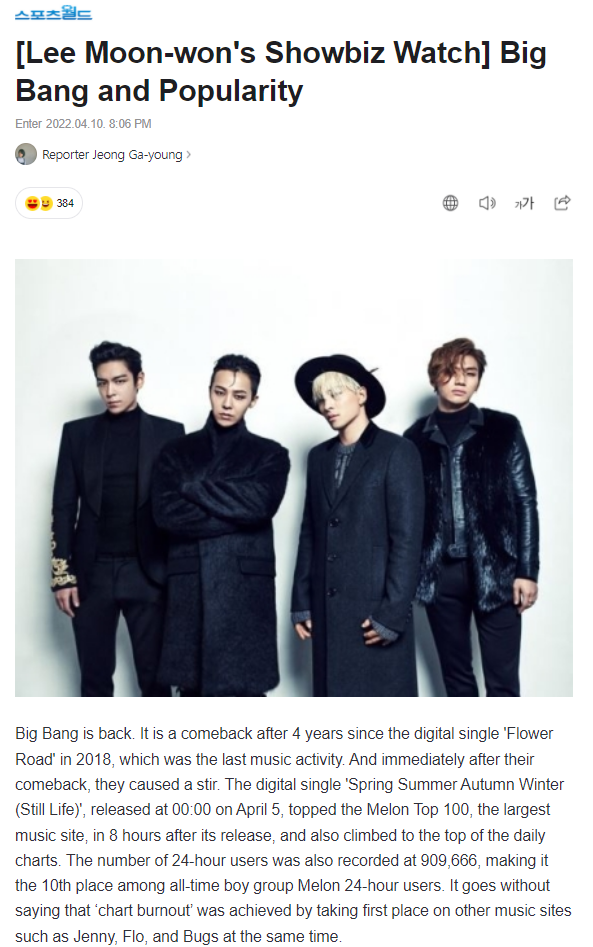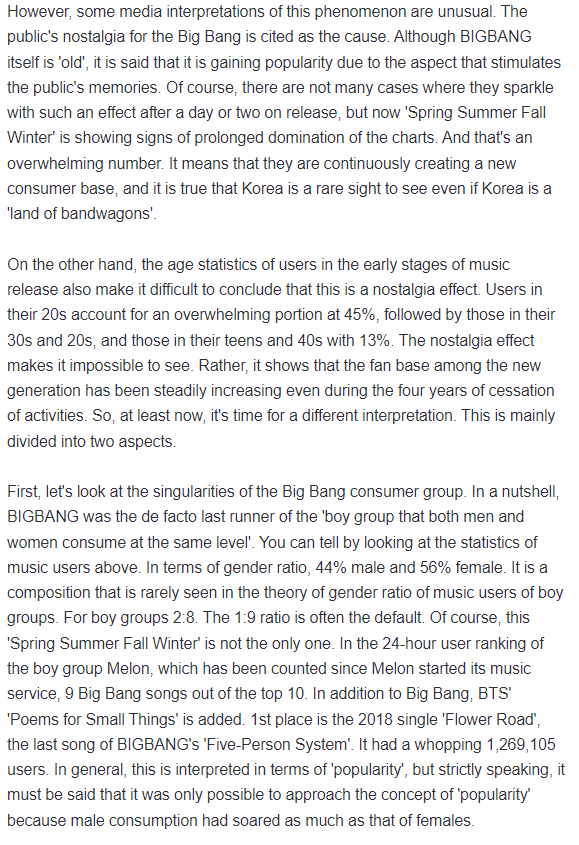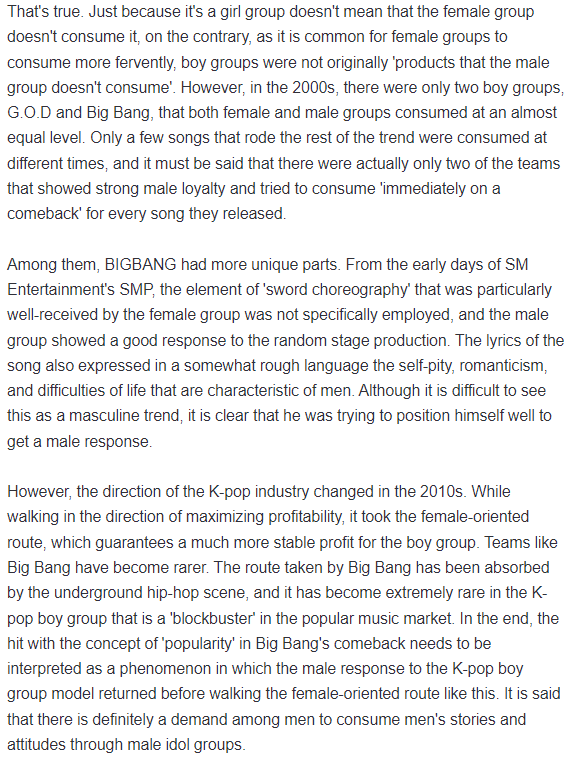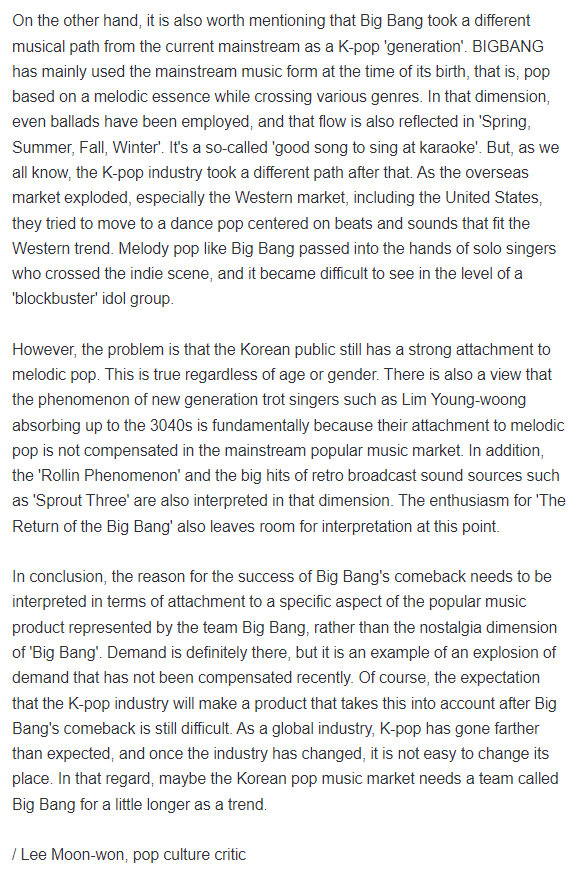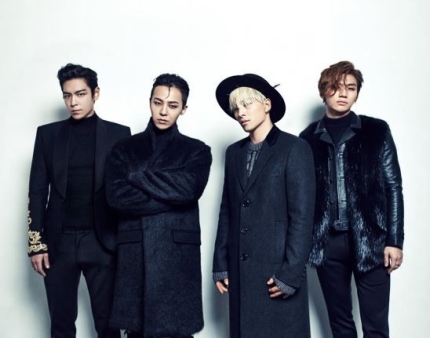 |
However, some media interpretations of this phenomenon are unusual. The public’s nostalgia for the BIGBANG is cited as the cause. Although BIGBANG itself is ‘old’, it is said that it is gaining popularity due to the aspect that stimulates the public’s memories. Of course, there are not many cases where they sparkle with such an effect after a day or two on release, but now ‘봄여름가을겨울’ is showing signs of prolonged domination of the charts. And that’s an overwhelming number. It means that they are continuously creating a new consumer base, and it is true that Korea is a rare sight to see even if Korea is a ‘land of bandwagons’.
On the other hand, the age statistics of users in the early stages of music release also make it difficult to conclude that this is a nostalgia effect. Users in their 20s account for an overwhelming portion at 45%, followed by those in their 30s and 20s, and those in their teens and 40s with 13%. The nostalgia effect makes it impossible to see. Rather, it shows that the fan base among the new generation has been steadily increasing even during the four years of cessation of activities. So, at least now, it’s time for a different interpretation. This is mainly divided into two aspects.
First, let’s look at the singularities of the BIGBANG consumer group. In a nutshell, BIGBANG was the de facto last runner of the ‘boy group that both men and women consume at the same level’. You can tell by looking at the statistics of music users above. In terms of gender ratio, 44% male and 56% female. It is a composition that is rarely seen in the theory of gender ratio of music users of boy groups. For boy groups 2:8. The 1:9 ratio is often the default. Of course, this ‘봄여름가을겨울’ is not the only one. In the 24-hour user ranking of the boy group Melon, which has been counted since Melon started its music service, 9 BIGBANG songs out of the top 10. In addition to BIGBANG, BTS’ ‘Poems for Small Things’ is added. 1st place is the 2018 single ‘Flower Road’, the last song of BIGBANG’s ‘Five-Person System’. It had a whopping 1,269,105 users. In general, this is interpreted in terms of ‘popularity’, but strictly speaking, it must be said that it was only possible to approach the concept of ‘popularity’ because male consumption had soared as much as that of females.
That’s true. Just because it’s a girl group doesn’t mean that the female group doesn’t consume it, on the contrary, as it is common for female groups to consume more fervently, boy groups were not originally ‘products that the male group doesn’t consume’. However, in the 2000s, there were only two boy groups, G.O.D and BIGBANG, that both female and male groups consumed at an almost equal level. Only a few songs that rode the rest of the trend were consumed at different times, and it must be said that there were actually only two of the teams that showed strong male loyalty and tried to consume ‘immediately on a comeback’ for every song they released.
Among them, BIGBANG had more unique parts. From the early days of SM Entertainment’s SMP, the element of ‘sword choreography’ that was particularly well-received by the female group was not specifically employed, and the male group showed a good response to the random stage production. The lyrics of the song also expressed in a somewhat rough language the self-pity, romanticism, and difficulties of life that are characteristic of men. Although it is difficult to see this as a masculine trend, it is clear that he was trying to position himself well to get a male response.
However, the direction of the K-pop industry changed in the 2010s. While walking in the direction of maximizing profitability, it took the female-oriented route, which guarantees a much more stable profit for the boy group. Teams like BIGBANG have become rarer. The route taken by BIGBANG has been absorbed by the underground hip-hop scene, and it has become extremely rare in the K-pop boy group that is a ‘blockbuster’ in the popular music market. In the end, the hit with the concept of ‘popularity’ in BIGBANG’s comeback needs to be interpreted as a phenomenon in which the male response to the K-pop boy group model returned before walking the female-oriented route like this. It is said that there is definitely a demand among men to consume men’s stories and attitudes through male idol groups.
On the other hand, it is also worth mentioning that BIGBANG took a different musical path from the current mainstream as a K-pop ‘generation’. BIGBANG has mainly used the mainstream music form at the time of its birth, that is, pop based on a melodic essence while crossing various genres. In that dimension, even ballads have been employed, and that flow is also reflected in ‘Spring, Summer, Fall, Winter’. It’s a so-called ‘good song to sing at karaoke’. But, as we all know, the K-pop industry took a different path after that. As the overseas market exploded, especially the Western market, including the United States, they tried to move to a dance pop centered on beats and sounds that fit the Western trend. Melody pop like BIGBANG passed into the hands of solo singers who crossed the indie scene, and it became difficult to see in the level of a ‘blockbuster’ idol group.
However, the problem is that the Korean public still has a strong attachment to melodic pop. This is true regardless of age or gender. There is also a view that the phenomenon of new generation trot singers such as Lim Young-woong absorbing up to the 3040s is fundamentally because their attachment to melodic pop is not compensated in the mainstream popular music market. In addition, the ‘Rollin Phenomenon’ and the big hits of retro broadcast sound sources such as ‘Sprout Three’ are also interpreted in that dimension. The enthusiasm for ‘The Return of the BIGBANG’ also leaves room for interpretation at this point.
In conclusion, the reason for the success of BIGBANG’s comeback needs to be interpreted in terms of attachment to a specific aspect of the popular music product represented by the team BIGBANG, rather than the nostalgia dimension of ‘BIGBANG’. Demand is definitely there, but it is an example of an explosion of demand that has not been compensated recently. Of course, the expectation that the K-pop industry will make a product that takes this into account after BIGBANG’s comeback is still difficult. As a global industry, K-pop has gone farther than expected, and once the industry has changed, it is not easy to change its place. In that regard, maybe the Korean pop music market needs a team called BIGBANG for a little longer as a trend.
/ Lee Moon-won, pop culture critic
Source: Naver
